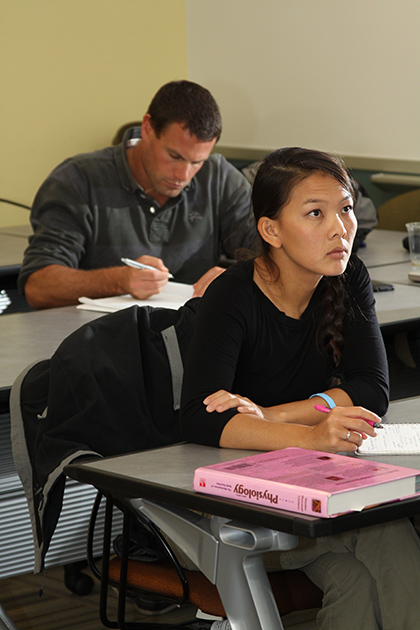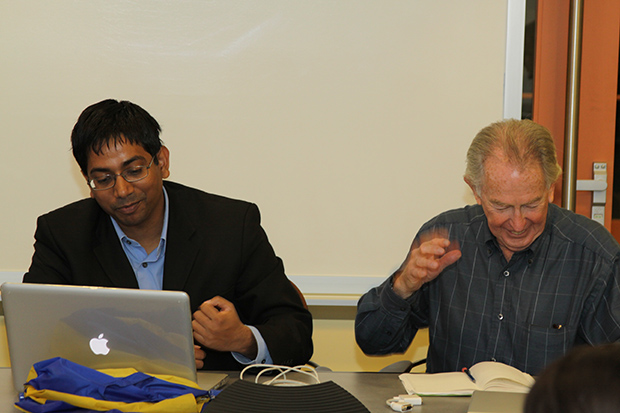
Program Trains Professionals in Medical Device Engineering
By:
- Catherine Hockmuth
Published Date
By:
- Catherine Hockmuth
Share This:
Article Content

Medical Device Engineering Graduate students and UC San Diego alumni Dan Braun, '06, and Noreen Jue, '04, listen to a presentation by Biological Dynamics founder Raj Krishnan who earned his Ph.D in bioengineering at the Jacobs School in 2010.
Dan Braun earned a bachelor’s in mechanical engineering at the University of California, San Diego in 2006. Five years later he came back to enroll in the inaugural class of the UC San Diego Jacobs School of Engineering’s Master of Advanced Study Program in Medical Device Engineering. The cross-disciplinary program is designed to train working professionals to apply their engineering know-how and workforce experience to a new career in one of the region’s fastest growing technology sectors.
Like Braun, some students are career changers, including an oceanographer from Scripps Institution of Oceanography. Braun wants to work in the design and fabrication of medical devices. Others already work in the field of medical devices and are using the program to change their trajectory into research and development, or quality control. Or to start a new company (with their feet solidly planted in reality).
“One of my realizations is that this program will prepare you for a lot,” said Braun, who plans to gain experience working in the medical devices field before he considers branching off on his own. “But you have to do your homework.”
According to BIOCOM, the San Diego-based life sciences trade group, these students have targeted their career plans well. San Diego and Southern California are hotbeds for the medical device industry. With 715 regional companies, the medical device sector is the region’s largest employer with an average salary of $105, 903. From 2009 to 2011, the sector added 2,345 new jobs in the region, a rate of 7 percent growth. BIOCOM predicts the sector will grow another 5 percent over the next two years.
“We want our students to be engaged in new revolutionary ideas in medical devices with a very strong grip on reality and with as much possible understanding of all the economic aspects of developing a device,” said Juan C. Lasheras, a professor of mechanical and aerospace engineering and co-director of the two-year program. “We not only want to train them on the very important, technical aspects of the designs of devices but also we want them to be very aware of the regulatory process and the financial implications.”
During a lunch break from a recent class in which they dissected the merits and weaknesses in each other’s ideas for medical devices, the students talked about why they enrolled in the program and what they are learning. The list is long. There is the program’s emphasis on developing products that are rooted in a thorough understanding of clinical needs. In year one, which is just concluding, the students spent much of their time learning about the clinical needs of several medical fields such as diabetes and surgical devices.

Biological Dynamics CEO Raj Krishnan (Ph.D, bioengineering, '10) and Bioengineering Professor John Watson during a recent class. Watson is co-director of the Master of Advanced Study program in Medical Devices Engineering, which is designed for early to mid-career engineering professionals who are on a technical leadership track within their companies, or who are interested in learning the business development and regulatory issues associated with the design of novel devices and instrumentation.
For example, during a lecture on the future of surgical devices last fall, Dr. Sonia Ramamoorthy, a professor of surgery at UC San Diego Health Systems, said surgeons need smarter instruments that can provide real-time feedback during an operation, advanced surgery simulation tools, mobile platforms and telesurgery that would enable operations in remote areas or facilitate communication with specialists via Skype-like communications, and artificial intelligence for diagnosis and treatment.
“We are looking at the current state of treatment and identifying where there is room for improvement and innovation,” said student Noreen Jue, who earned a bachelor’s in bioengineering from UC San Diego in 2004 and now works as an engineer for a medical devices company in Orange County. Jue and several other students also eagerly cited the program’s focus on entrepreneurism. And everyone touted its high quality and rigorous curriculum that still manages to cater to busy working professionals. Classes meet every other Friday and Saturday.
Product Development
In the coming year, the students will design and develop a prototype device. They have ongoing opportunities to learn from experts in a diverse set of fields that are at the core of the next generation of medical devices, including bioengineering, biomaterials, genomics, computing and telecommunications. They are also being immersed in healthcare economics, navigating the regulatory process, standards and compliance, and project management and leadership. The breadth of the curriculum is supported by a synergistic partnership between UC San Diego’s top ranked medical and engineering schools, and programs such as the Institute of Engineering in Medicine (IEM). The IEM was developed at UC San Diego to facilitate collaborations between engineers and doctors looking to translate their research into novel products and treatments that could transform healthcare.
Bioengineering professor John Watson, the program’s co-director, said the medical device industry is loaded with opportunities in part because most of the industry is made up of small, creative companies. By comparison, drug development is dominated by pharmaceutical giants. “This is a ‘produce something’ program,” said Watson. “At the end they will have something they can hold in their hands.”
Lasheras and Watson believe they are on a path to an important product of their own: a unique program to take engineers who have already mastered a core engineering discipline and have work experience, train and expose them to the broad field of medical device engineering, and then guide them through the whole process of the creation of a novel diagnostic or therapeutic medical device.
A second cohort of students will enter the program this fall, but Lasheras is not measuring the program’s progress by enrollment. He is focused on producing high quality students, who have been engaged in interesting, challenging and meaningful projects. “We will build the reputation of the program by the actions of students and where they are going when they finish at UCSD,” Lasheras said.
Share This:
You May Also Like
Stay in the Know
Keep up with all the latest from UC San Diego. Subscribe to the newsletter today.


